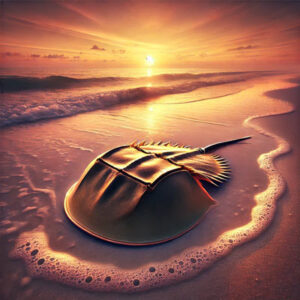 On the shores of Florida, where the waves slip in and out with the patience of something that has always been and will always be, the ancient ones still crawl. Their armored bodies glisten in the tide, their long, spined tails tracing patterns in the sand. To some, they look alien—strange relics of another world. And in a way, they are.
On the shores of Florida, where the waves slip in and out with the patience of something that has always been and will always be, the ancient ones still crawl. Their armored bodies glisten in the tide, their long, spined tails tracing patterns in the sand. To some, they look alien—strange relics of another world. And in a way, they are.
Horseshoe crabs have been here for over 450 million years. Long before the dinosaurs roamed the Earth, before the first trees took root, before the continents drifted into the familiar shapes we know today, these creatures were already scuttling along the ocean floor. They have survived ice ages, mass extinctions, and the slow, relentless reshaping of the planet. They have watched time stretch and twist, witnessed the rise and fall of empires, outlived entire species.
And yet, here they are, washing up on Florida’s shores as they have for millennia, their presence a quiet reminder that not everything is fleeting.
The Keepers of Another Era
There’s something humbling about seeing a horseshoe crab up close. Its domed shell, ridged and worn, looks like something that belongs in a museum exhibit. Its long, spiny tail moves like an afterthought, dragging behind its slow, deliberate steps. It has ten eyes, scattered across its body like tiny relics of evolution, sensing light and movement in ways we barely understand.
Despite their fearsome appearance, they are harmless, gentle travelers of the tides. They do not pinch or sting. They do not hunt. They move with the patience of something that has nothing left to prove.
Lessons from the Survivors
In a world obsessed with speed, with newness, with forward motion, horseshoe crabs remind us of the value of resilience. They are living fossils, their design so perfectly suited to survival that it has remained virtually unchanged for hundreds of millions of years. They teach us that endurance is its own kind of wisdom.
Every spring, under the full moon, they gather on sandy shores, their mating rituals dictated by tides older than humanity itself. The eggs they lay will feed migratory shorebirds that rely on them to survive their long journeys. In this way, the horseshoe crab is not just a relic of the past but a crucial piece of an ongoing cycle, quietly shaping the world in ways we barely notice.
A Fragile Future
For all their ancient strength, horseshoe crabs are not invincible. Their numbers are declining due to habitat loss, overharvesting, and climate change. They are used in biomedical research—their blue blood contains a compound vital for detecting bacterial contamination in vaccines and medical devices. Though efforts are being made to develop synthetic alternatives, they are still bled in staggering numbers.
It is strange to think that a creature that has survived mass extinctions, asteroid impacts, and ice ages could now be at risk because of us.
The Ancient Ones Endure
And yet, if there is anything the horseshoe crab has taught us, it is that survival is possible. That time is vast. That some things, even in a rapidly changing world, can still hold on.
So the next time you walk along a Florida shore and see one of these strange, beautiful creatures half-buried in the sand, stop for a moment. Watch. Appreciate the quiet persistence of something that has outlived the unimaginable. Because in a world that often feels like it’s moving too fast, the ancient ones remind us that there is still value in simply enduring.
